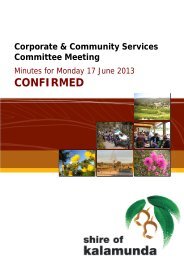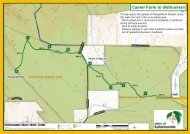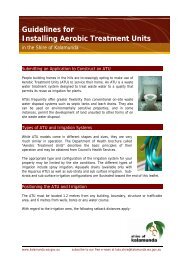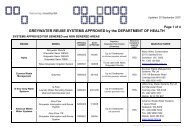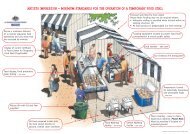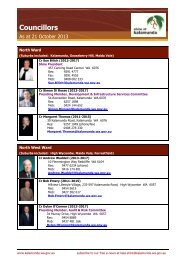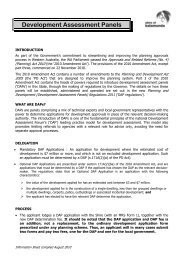Local Biodiversity Strategy: - Shire of Kalamunda
Local Biodiversity Strategy: - Shire of Kalamunda
Local Biodiversity Strategy: - Shire of Kalamunda
Create successful ePaper yourself
Turn your PDF publications into a flip-book with our unique Google optimized e-Paper software.
In recognition <strong>of</strong> the ecological function <strong>of</strong> waterways, a target for waterways has<br />
been drafted. This target is detailed in Box 8.<br />
Box 8: Preferred Target for Rivers, creeklines and other channel waterways<br />
Retain and protect riparian vegetation and upland vegetation in moderate or<br />
better condition associated with rivers, creeklines, other channel waterways<br />
and floodplain areas. Retain sufficient buffer distance to maintain the<br />
ecological function <strong>of</strong> the watercourse. Where practicable, enhance natural<br />
areas containing waterways to maintain and improve biodiversity values.<br />
8.3 Maintaining Ecological Processes<br />
8.3.1 Ecological Linkages<br />
Ecological linkages are non-contiguous, natural areas that connect larger natural<br />
areas by forming stepping stones that allow the movement, over time, <strong>of</strong> organisms<br />
between larger areas. Habitat fragmentation is a key threatening process leading to<br />
the loss <strong>of</strong> biodiversity (refer to Section 4.4). Survival <strong>of</strong> species within natural<br />
areas will depend on well planned and managed ecological linkages.<br />
Regional ecological linkages link protected Regionally Significant Natural Areas<br />
(RSNAs) by retaining the best condition LNAs available between them that can act as<br />
stepping stones for flora and fauna. This increases the long-term viability <strong>of</strong> the<br />
RSNAs as well as the LNAs in the link. To be effective the linkages should incorporate<br />
the major variation in plant communities and fauna habitat typical <strong>of</strong> the region so<br />
that the widest range <strong>of</strong> flora and fauna possible can use the links.<br />
Regional ecological linkages have been identified by PBP with input from DEC and<br />
DPI. It is proposed that the Regional Ecological Linkages identified by PBP are<br />
accepted for inclusion into the <strong>Local</strong> <strong>Biodiversity</strong> <strong>Strategy</strong>. On-ground assessment<br />
will however be required prior to making planning decisions enforcing the proposed<br />
linkage target.<br />
<strong>Local</strong> ecological linkages are an important part <strong>of</strong> improving the viability <strong>of</strong> natural<br />
areas that may be too small or in too poor shape or condition to be viable on their<br />
own if isolated. The <strong>Shire</strong> <strong>of</strong> <strong>Kalamunda</strong> identified a number <strong>of</strong> local ecological<br />
linkages as part <strong>of</strong> the development <strong>of</strong> the Wildlife Corridors <strong>Strategy</strong> 1998.<br />
<strong>Local</strong> ecological linkages should aim to link protected <strong>Local</strong>ly Significant Natural<br />
Areas (LSNAs) to other LSNAs, protected regionally significant natural areas and<br />
Regional Ecological Linkages. The linkages recognised in the Wildlife Corridors<br />
<strong>Strategy</strong> should be assessed to ensure that these linkages meet current criteria for<br />
local ecological linkages. Regional ecological linkages and wildlife corridors are<br />
detailed in Figure 5.<br />
<strong>Local</strong> <strong>Biodiversity</strong> <strong>Strategy</strong> Page 45



